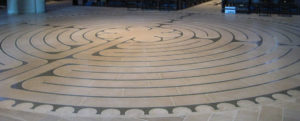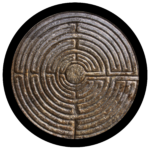Notes on the Labyrinth
Furthermore, we have not even to risk the adventure alone, for the heroes of all time have gone before us. The labyrinth is thoroughly known…. Where we had thought to travel outward, we shall come to the center of our own existence. And where we had thought to be alone, we shall be with all the world.
— Joseph Campbell

Labyrinths have been around in various forms for over 3500 years, appearing in ancient ruins of places as diverse as Peru, North America, Crete, Egypt, Iceland and India.(1) They have served a wide variety of purposes and symbolized many things, although the one most common element appears to have often been a spiritual connection for those attracted to them. Perhaps the most famous early tale of labyrinths is found in the legend of Theseus: the labyrinth on Crete was constructed for King Minos and designed by the legendary artificer Daedalus to hold the Minotaur, a creature that was half man and half bull, and which was eventually killed by Theseus. Theseus in turn was aided by Ariadne, who provided him with a thread to wind his way back out again.(2)
King Minos’ labyrinth is more accurately called a maze these days, as it was possible to get lost in it by taking a wrong turn. An actual labyrinth has only one way in, and one way out. There is no way to get lost.
In the Middle Ages the labyrinth once more became popular, first of all interestingly enough for certain Scandinavian tribes, who constructed them as a means of trapping malevolent trolls or winds that could have spelled trouble for the local fishing boats, and also for the Christian church, who saw them as a representation of the soul’s path through life. “The full flowering of the medieval labyrinth design came about during the twelfth and thirteenth centuries with the grand pavement labyrinths of the gothic cathedrals, most notably Chartres, Reims and Amiens in northern France and the Duomo di Siena in Tuscany.”(3)
The labyrinth that’s featured on these pages is from the portico of the cathedral of San Martino at Lucca, Tuscany. The cathedral was constructed around 1200 AD, although some sources believe the labyrinth itself is an earlier piece dating from Roman times. This is doubtful though, as it’s constructed in the medieval style (an 11 circuit design). The Latin inscription next to it reads: “This is the labyrinth which Daedalus constructed for Crete, out of which nobody who was inside shall get out, except Theseus”.(4)
These days labyrinths have experienced a resurgence as a means of meditation and personal spiritual practice; the walking of the labyrinth allows one to lose track of the outside world as it calms the mind and quiets the internal dialogue, something which can aid greatly in mindfulness (see Philosophy).
I took the symbol of the labyrinth as my inspiration in constructing this website because of my own personal attachment to actual labyrinths that I have known and walked. For years I struggled with a way to reconcile my spiritual searching and my own personal orientation towards movement and kinesthetics. I often had difficulty in just sitting still and meditating but found I could achieve a mindful state by finding a labyrinth and walking it. As I began to explore labyrinths in their different forms and in the various locations where they could be found, I started to realize also the parallel that they represented to me for my own ideas around the psyche, myths and the collective unconscious.
(If you would like to check out some pictures of some of the labyrinths that I have walked you can visit my Labyrinth Photos page.)
From the shamanic journeying of indigenous mystics to Joseph Campbell’s Hero’s Journey,(5) the theme arises again and again of a foray into the underworld (the unconscious?), in order to complete a task and then return again to the community to share whatever has been achieved or learned or obtained. Like the labyrinth, the way can be known and taken with assurance and few wrong turns, if the explorer has the right training and assistance. There are challenges along the way, and the searcher is often tested, but in the end there is not only a return to the common everyday, but the one who returns is often not the same as the one who left. Transformation, transcendence, transubstantiation.
And not only there does this theme emerge, but in popular culture as well. How similar is this to Alice’s journey through Wonderland? To Harry Potter’s descent into the Chamber of Secrets to slay the basilisk?(6) Once I started looking for examples of this theme, it began to show up almost everywhere I turned. I was struck by the universality of the concept, how it appeared in so many different cultures and common myths, and began to wonder what the relationship was between this and any possible universal archetypes at the core of the human experience.
How does this play into psychotherapy? There is in therapy, as in any sort of undertaking that’s centered around growth and evolution, the need to examine and reexamine the seeker’s inner workings, to follow the natural, organic thread of the psyche as it winds it’s way down and down towards the center of the Self, the center of the mind’s labyrinth. Like the Hero’s Journey, once the core has been reached and the necessary work been done, there is a reemergence into the light of day that brings forth a new Self that’s more in harmony with who the seeker wishes themselves to be, a Self that’s more in harmony with the world around them. Those journeying return changed for the better, and are able to find more enjoyment and satisfaction with their lives as a result. The Therapist, like Ariadne, provides the thread that allows the seeker to find their way down and back.
I invite you therefore to join me on a journey through the labyrinth, to seek and explore, and to come out of the experience changed for the better, with wisdom and talents to share with yourself and those around you.
References
1. Jeff Saward, Editor, Caerdroia
2. Wikipedia Prayer Labyrinth
3. Wikipedia Labyrinth
4. Art and History of Lucca in Tuscany
5. Joseph Campbell Foundation
6. Harry Potter Wikipedia
Back to top
